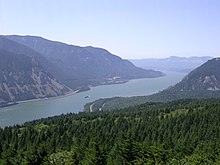natural
Natural environment
In contrast to the natural environment is the built environment. In such areas where man has fundamentally transformed landscapes such as urban settings and agricultural land conversion, the natural environment is greatly modified into a simplified human environment. Even acts which seem less extreme, such as building a mud hut or a photovoltaic system in the desert, modify the natural environment into an artificial one. Though many animals build things to provide a better environment for themselves, they are not human, hence beaver dams and the works of Mound-building termites are thought of as natural.
Oceans
An ocean is a major body of saline water, and a component of the hydrosphere. Approximately 71% of the Earth's surface (an area of some 362 million square kilometers) is covered by ocean, a continuous body of water that is customarily divided into several principal oceans and smaller seas. More than half of this area is over 3,000 meters (9,800 ft) deep. Average oceanic salinity is around 35 parts per thousand (ppt) (3.5%), and nearly all seawater has a salinity in the range of 30 to 38 ppt. Though generally recognized as several 'separate' oceans, these waters comprise one global, interconnected body of salt water often referred to as the World Ocean or global ocean.[5][6] The deep seabeds are more than half the Earth's surface, and are among the least-modified natural environments. The major oceanic divisions are defined in part by the continents, various archipelagos, and other criteria: these divisions are (in descending order of size) the Pacific Ocean, the Atlantic Ocean, the Indian Ocean, the Southern Ocean and the Arctic Ocean.

Rivers
A river is a natural watercourse,[7] usually freshwater, flowing toward an ocean, a lake, a sea or another river. A few rivers simply flow into the ground and dry up completely before reaching another body of water.
he water in a river is usually in a channel, made up of a stream bed between banks. In larger rivers there is also a wider floodplain shaped by waters over-topping the channel. Flood plains may be very wide in relation to the size of the river channel. Rivers are a part of the hydrological cycle. Water within a river is generally collected from precipitation through surface runoff, groundwater recharge, springs, and the release of water stored in glaciers and snowpacks.
Small rivers may also be termed by several other names, including stream, creek and brook. Their current is confined within a bed and stream banks. Streams play an important corridor role in connecting fragmented habitats and thus in conserving biodiversity. The study of streams and waterways in general is known as surface hydrology.
Atmosphere, climate and weather
The atmosphere of the Earth serves as a key factor in sustaining the planetary ecosystem. The thin layer of gases that envelops the Earth is held in place by the planet's gravity. Dry air consists of 78% nitrogen, 21% oxygen, 1% argon and other inert gases, such as carbon dioxide. The remaining gases are often referred to as trace gases,[12] among which are the greenhouse gases such as water vapor, carbon dioxide, methane, nitrous oxide, and ozone. Filtered air includes trace amounts of many other chemical compounds. Air also contains a variable amount of water vapor and suspensions of water droplets and ice crystals seen as clouds. Many natural substances may be present in tiny amounts in an unfiltered air sample, including dust, pollen and spores, sea spray, volcanic ash, and meteoroids. Various industrial pollutantsalso may be present, such as chlorine (elementary or in compounds), fluorine compounds, elemental mercury, and sulphur compounds such as sulphur dioxide [SO2].
The ozone layer of the Earth's atmosphere plays an important role in depleting the amount of ultraviolet (UV) radiation that reaches the surface. As DNA is readily damaged by UV light, this serves to protect life at the surface. The atmosphere also retains heat during the night, thereby reducing the daily temperature extremes
thank you



Comments
Post a Comment